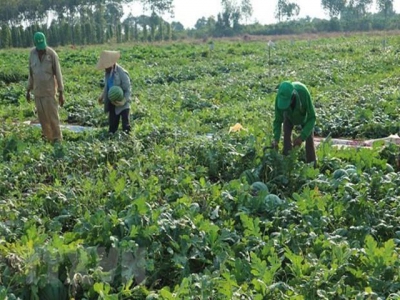Seeds for seedless watermelons exported to Japan

Ho Chi Minh City (VNA) - Loc Troi Group, a leading provider of agricultural services and products in Vietnam, on July 23 announced it had exported 8.1 kg of seeds that will grow into seedless watermelons to Japan.
Harvesting watermelons on a field as part of the Loc Troi - Hagihara Farm project (Photo: VNA)
According to Chairman of the group Huynh Van Thon, the seeds are part of a project between Loc Troi and Japanese-based Hagihara Farm Co., Ltd., which aims to teach Japanese watermelon cultivation techniques to Vietnamese farmers to build an organic model in the country. The project also targets the production and distribution of the seeds in Vietnam as well as their export to Japan and elsewhere.
Mai Tan Hoang, deputy head of Loc Troi’s research and development department, said one of the toughest requirements is to ensure the formation of a 99.9-percent purebred variety unharmed by microorganisms. This means strict standards for soil quality and temperature as well as the separation the seedless plantations from normal ones to avoid unwanted pollination.
Tran Viet Truong, a farmer in Hau Giang’s Chau Thanh district who was involved in the production of the first seed batch sent to Japan, said compared to growing normal commercial watermelons, the process for the Japanese variety requires much more advanced techniques.
The project has been carried out in the Mekong Delta province of Hau Giang and Tien Giang, with initial success of the first 8.1 kg of 99.97-percent purebred seeds for export.
Related news
 Agro-forestry-fishery exports drop nearly 3 percent in Q1
Agro-forestry-fishery exports drop nearly 3 percent in Q1 Agro-forestry-fishery exports are estimated to have yielded 8.8 billion USD in the year’s first quarter, a year-on-year fall of 2.9 percent
 Vietnamese supermarkets replacing plastic bags with banana leaves
Vietnamese supermarkets replacing plastic bags with banana leaves Some supermarkets in Vietnam have been wrapping food in environmentally friendly products like fresh banana leaves, beginning a new trend as people are becoming
 Southern region plans to grow other crops on low-yield rice fields
Southern region plans to grow other crops on low-yield rice fields The Mekong Delta and the south-eastern region plan to grow other crops on more than 126,300ha of low-yield rice fields this year as a means of adapting
 African swine fever presents opportunity for Vietnam’s large-scale livestock enterprises
African swine fever presents opportunity for Vietnam’s large-scale livestock enterprises Consumers will gradually shift to purchasing from modern distribution channels dominated by large-scale enterprises such as supermarkets, grocery stores
 Rural districts in HCM City to develop agri-tourism
Rural districts in HCM City to develop agri-tourism The HCM City People’s Committee has instructed the city’s tourism sector and authorities of its five suburban districts to develop agri-tourism